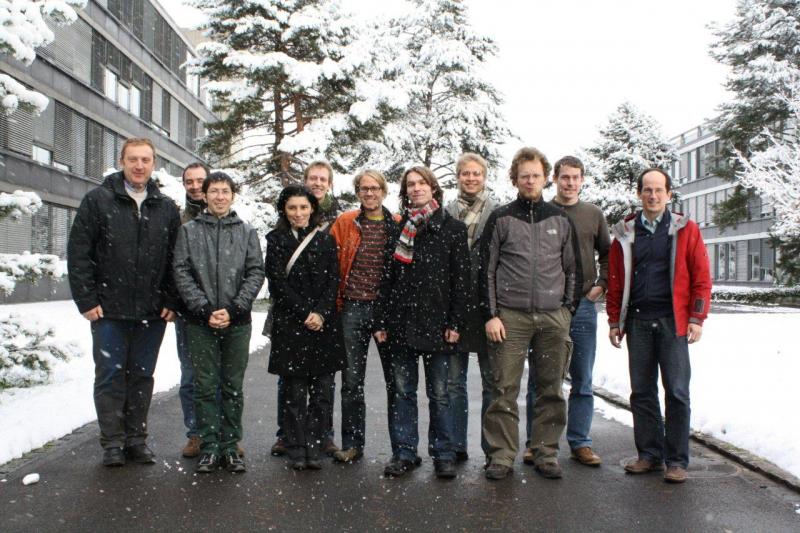GEOMDISS
GEOMDISS second review
Thu, 2011-06-16 11:20 - Ingo KamleitnerThe second review meeting will be hosted by Scuola Normale Superiore di Pisa.
Geometric quantum gates with superconducting qubits
Mon, 2011-04-04 10:12 - Ingo KamleitnerPhys. Rev. B 83, 214518 (2011)
We suggest a scheme to implement a universal set of non-Abelian geometric transformations for a single logical qubit composed of three superconducting qubits coupled to a single cavity. The scheme utilizes an adiabatic evolution in a rotating frame induced by the effective tripod Hamiltonian which is achieved by longitudinal driving of the qubits. The proposal is experimentally feasible with the current state of the art and could serve as a first proof of principle for geometric quantum computing.
Cooper Pair Pumping Workshop
Mon, 2011-02-14 17:28 - Ingo KamleitnerWe discuss various aspects of Cooper pair pumping.
Holonomy Meeting
Tue, 2010-12-14 15:13 - Ingo Kamleitner
We discussed several ideas for the implementation on non-Abelian holonomies using superconducting qubits of the transmon type. In particular, their experimental feasibility was compared. Some proposals could be ruled out right away, whereas others need to by studied in more detail before the most promising scheme can be singled out and experiments can begin.
Holonomies
Wed, 2010-10-20 14:29 - Ingo KamleitnerSome members of the group met from 25/11 to 26/11/2010 in Zurich to discuss non-Abelian holonomies. This resulted in a theoretical publication and ongoing experimental effort to measure an holonomy.
SNS-Pisa - Condensed Matter and Quantum Information Theory Group
Mon, 2010-10-18 09:51 - rosario FazioQuantum Information
Control and tomography of a three level superconducting artificial atom
Wed, 2010-10-06 11:07 - Ingo KamleitnerPhys. Rev. Lett. 105, 223601 (2010)
A number of superconducting qubits, such as the transmon or the phase qubit, have an energy level structure with small anharmonicity. This allows for convenient access of higher excited states with similar frequencies. However, special care has to be taken to avoid unwanted higher-level populations when using short control pulses. Here we demonstrate the preparation of arbitrary three level superposition states using optimal control techniques in a transmon.
Nonequilibrium transport theory of the singlet-triplet transition: Perturbative approach
Wed, 2010-10-06 11:02 - Ingo KamleitnerPhys. Rev. B 82, 165129 (2010)
We use a simple iterative perturbation theory to study the singlet-triplet (ST) transition in lateral and vertical quantum dots, modeled by the nonequilibrium two-level Anderson model. To a great surprise, the region of stable perturbation theory extends to relatively strong interactions, and this simple approach is able to reproduce all experimentally observed features of the ST transition, including the formation of a dip in the differential conductance of a lateral dot indicative of the two-stage Kondo effect, or the maximum in the linear conductance around the transition point.
Spin-Dependent Transport through Quantum-Dot Aharonov-Bohm Interferometers
Wed, 2010-10-06 10:57 - Ingo KamleitnerPhys. Rev. B 82, 165452 (2010)
We study the influence of spin polarization on the degree of coherence of electron transport through interacting quantum dots. To this end, we identify transport regimes in which the degree of coherence can be related to the visibility of the Aharonov-Bohm oscillations in the current through a quantum-dot Aharonov-Bohm interferometer with one normal and one ferromagnetic lead. For these regimes, we calculate the visibility and, thus, the degree of coherence, as a function of the degree of spin polarization of the ferromagnetic lead.

